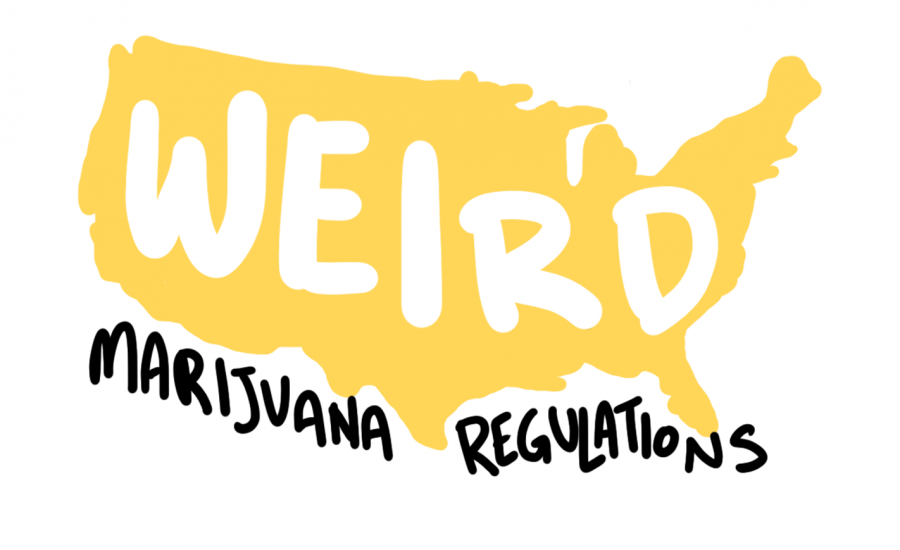So you want to know about weird marijuana regulations
As we all know (hopefully), marijuana is illegal under federal law. In spite of that law, 30 states now allow the sale of marijuana in some capacity. Except for a few short memos from the U.S. Attorney General’s office, states have little guidance on how to set up a system for cannabis control. The memos only seem to require preventing marijuana from being redirected out of state or into the hands of minors or illegal-market players (see Cole memo). This lack of guidance enables individual states to tackle regulations creatively.
With 30 different states trying to build a regulated industry after decades of prohibition, the results are varied. For a business, juggling 30 different regulatory environments sounds like a headache. However, to a regulatory analyst (that’s me!), it’s a wonky wonderland. Here are a few of my favorite weird marijuana regulations I’ve found as a side-effect to these state experiments:
California vs. New Mexico: How many license types do we need?
California

California is well-known for being a state of complex regulations, and their cannabis rules are shaping up to be no exception. Perhaps you would expect to have a separate license for each part of the business that handles marijuana: growers, retailers, product manufacturers, transporters, testing labs, and maybe distributors. In addition, many state outline different licenses for recreational vs. medicinal marijuana. That would put you at about 16 license types in a state with recreational and medical uses permitted—eight for medical only states. But things are not so simple in The Golden State.
California has over 50 license types. They have licenses for manufacturers who use volatile solvents, and a separate one for those who use non-volatile solvents. They separate cultivation licenses depending on whether your grow is outdoor, indoor, or mixed-light; whether the grow is small or medium (but no large yet); or if the grow is “specialty” or “specialty cottage”—28 cultivation licenses in all. They even have a special license for Cannabis Event Organizers (both medical and recreational).
New Mexico

New Mexico, on the other hand, has one commercial license type and one for personal production and use. This license allows the licensee to grow, sell, and distribute medicinal marijuana. So about testing, manufacturing, and transport? In order to do these in New Mexico, you don’t get licensed from the state, you get approved. Different names for the same thing? Possibly. The approval process still requires an application fee and a review process that involves security, odor, and environmental concerns. The only difference seems to be that at the end of the approval process, your business gets added to a list of approved companies, while a license grants you an official piece of paper to display.
We have reached out to New Mexico’s licensing department but are still waiting on their response to clarify the difference *author subtly nudges New Mexico*. Even if you decide to count these approvals as a sort of half-license, it still only brings New Mexico’s count up to four total licenses. We don’t know which state has the best system—too many licenses and regulations can stunt business growth, while too few can create loopholes and, by extension, gray markets. As with most things in life, the answer probably lies somewhere in the middle.
Marijuana, Cannabis, and Marihuana: A bud by any other name…
Licensing isn’t the only marijuana regulation quirk I’ve encountered. Should we call the plant Marijuana or Cannabis? The two terms seem to divide states and localities.
The word “cannabis” is considered a more “professional” word because it refers to the taxonomical plant classification. Cannabis also has a broader meaning, applying to the whole plant.
The word “marijuana”, on the other hand, comes from Mexican farmers. People disagree on whether the word “marijuana” refers to the whole plant or just the THC-potent flowers. Also, whether it should be differentiated from hemp with a low-THC percentage.
Michigan’s marihuana history
As far as I can tell, the only state that is a one-off from this battle of words is Michigan.
Michigan’s regulations use the outdated spelling, “marihuana” (apparently British Columbia does this too). This spelling seems to date back to a time when U.S. citizens were unaware that “j”s can make an “h” sound in Spanish.
“Marihuana” appears in two places: the 1937 Marihuana Tax Act, one of the first pieces of federal legislation implementing cannabis-prohibition, and the 1970 Controlled Substances Act which kicked off the War on Drugs.
It makes sense that Michigan would use such a dated spelling; Michigan, at least in Ann Arbor, started fighting prohibition from the start. Since 1974, the city allowed possession of small amounts of marijuana and only imposed a civil infraction. According to Michigan’s government, it incorporated the spelling into its Public Health Code which is the standard spelling under federal law. They argue that it would take explicit action from the Michigan Legislature to update the spelling to something more current, which probably won’t happen any time soon.
We have yet to encounter a regulation that refers to weed, ganja, or mota… but we’ll let you know when we do.
Simplifya’s regulatory analysts take pride in their exhaustive knowledge of cannabis compliance. Their work enables our clients to easily understand the regulations they need to follow. See for yourself by signing up for a demo today!
